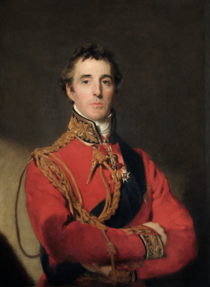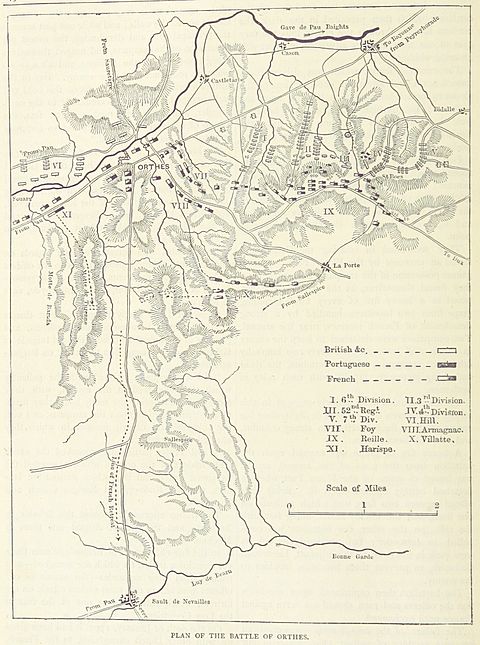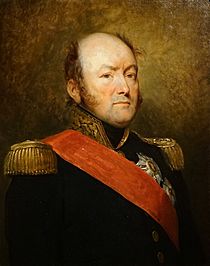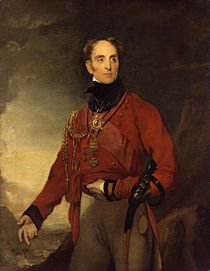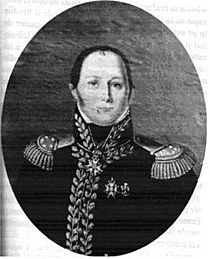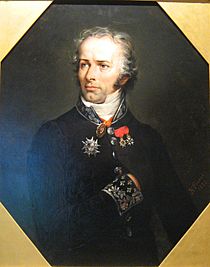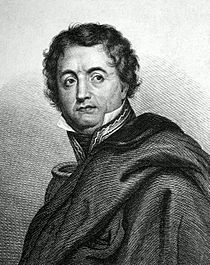Battle of Orthez facts for kids
Quick facts for kids Battle of Orthez |
|||||||
|---|---|---|---|---|---|---|---|
| Part of the Peninsular War | |||||||
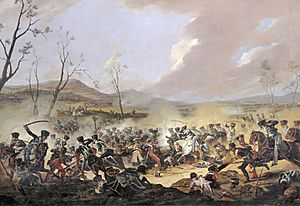 The Final Charge of the British Cavalry at the Battle of Orthez, by Denis Dighton |
|||||||
|
|||||||
| Belligerents | |||||||
| Commanders and leaders | |||||||
| Strength | |||||||
| 34,993 48 guns |
44,000 54 guns |
||||||
| Casualties and losses | |||||||
| 3,985 killed, wounded or captured 6 guns lost |
2,174 killed, wounded or captured | ||||||
The Battle of Orthez was a big fight that happened on February 27, 1814, in southern France. It was part of the Peninsular War. The British, Spanish, and Portuguese armies, led by Duke of Wellington, fought against the French army, led by Marshal Soult. Even though the French army was smaller, they fought hard. But in the end, Wellington's forces pushed them back, and Soult had to retreat. At first, the French retreated in an organized way. But soon, it turned into a rush for safety, and many French soldiers were captured. This battle happened near the end of the long Peninsular War.
Before this battle, Wellington's army had been pushing the French back from the area around Bayonne. They moved east, forcing the French to give up several river lines. After a short break, some of Wellington's troops surrounded Bayonne. The rest of the army kept moving east, pushing Soult's army all the way to Orthez. Here, Soult decided to stand and fight. After the battle, Soult chose to leave the important port city of Bordeaux and instead move his army east towards Toulouse. The next major battle was the Battle of Toulouse.
Contents
Getting Ready for Battle
The Armies
The fighting stopped for a while after the Battle of the Nive in December 1813. Marshal Soult's French army had tried to attack Wellington's forces but failed. Both armies then settled into winter camps. Heavy rains made it impossible to move for about two months.
Wellington was very strict with his soldiers. After an earlier battle, some of his Spanish troops had caused trouble in French villages. To avoid making French people angry and starting a guerrilla war, Wellington sent most of his Spanish soldiers home. Only Pablo Morillo's Spanish division stayed, as the British government paid and fed them. This strictness helped Wellington's army. His soldiers no longer needed to guard the roads behind them, as French civilians were not attacking them.
In January 1814, Soult had to send some of his best soldiers to help Napoleon in another war. This meant Soult's army became smaller. He had about 32,000 infantry (foot soldiers) and 3,800 cavalry (horse soldiers). Wellington's army was larger, with about 42,000 infantry and 3,000 cavalry.
Moving into Position
Wellington had a clever plan. He wanted to use most of his army to push Soult's forces far to the east, away from Bayonne. Once Soult was far enough, a strong part of Wellington's army would cross the Adour river near Bayonne and surround the city. Since Soult's army was smaller, Wellington felt confident enough to split his forces.
On February 14, Wellington started his attack, moving east. His right side, led by Rowland Hill, had about 20,000 soldiers. They attacked the French at Hélette. Hill's troops won the Battle of Garris on February 15, forcing the French to leave Saint-Palais and another river line.
Wellington's left side, with 25,400 soldiers led by William Beresford, started moving on February 16. Soult reacted by moving his divisions to form a new defense line behind the Gave d'Oloron River. On February 17, Hill's soldiers crossed another river, breaking yet another French defense line. Soult made a strange choice, sending one of his divisions to help defend Bayonne, which left him with fewer soldiers to fight Wellington. By February 18, Soult's troops were ready at the Gave d'Oloron, but bad weather stopped the fighting again.
During this break, Wellington ordered John Hope's troops to surround Bayonne. The Adour river near Bayonne was very wide and had strong tides, so Soult didn't think anyone would cross there. But Hope's soldiers did! On February 23, they crossed the river. The next day, 34 ships were used to build a floating bridge across the Adour. By the evening of February 26, Hope had marched 15,000 of his men across the river. The Allies then surrounded Bayonne on February 27.
On February 24, Wellington started a new attack against Soult's army. Hill's forces were made stronger for this. Beresford made a fake attack in the north to distract the French. Meanwhile, Thomas Picton's troops tried to cross the Gave d'Oloron river. They found a spot and sent some soldiers across, but the French fought back hard, and many Allied soldiers were captured or drowned. Hill then built a boat bridge and sent 20,000 troops across the river. With his defense line broken, Soult had to retreat to Orthez, on the Gave de Pau River.
The Battle of Orthez
Plans and Forces
Wellington wanted to avoid a direct fight if possible. He sent Beresford's troops to cross the Gave de Pau river further downstream and go around Soult's right side. At the same time, Hill's troops moved straight towards Orthez. By February 25, Soult had gathered his army at Orthez, ready for battle.
Soult had about 33,000 foot soldiers, 2,000 horse soldiers, and 48 cannons. Wellington had more troops: 38,000 infantry, 3,300 cavalry, and 54 cannons.
The Gave de Pau river protected Soult's position only to the east of Orthez. However, there was a high ridge north of Orthez, ending at the village of Saint-Boès in the west. This ridge was about 500 feet high, and the road to Dax ran along its top. Even higher points on the ridge, like Lafaurie, Luc, and Plassotte Farms, were topped with French cannons.
Soult placed most of his divisions along this ridge. One division was in Orthez, and one was kept in reserve. His right side was held by the divisions of Taupin, Rouget, and Darmagnac. The center was held by Foy's division. Harispe's troops held Orthez, and Villatte's division was in reserve.
Wellington's plan was for Lowry Cole's 4th Division, supported by Walker's 7th Division, to attack the western end of the ridge at Saint-Boès. Picton, with his 3rd Division and Clinton's 6th Division, would keep the French center busy. Hill's troops were to pretend to attack Orthez, then cross the Gave de Pau river east of the town to attack the French left side. Wellington hoped to trap Soult between Beresford and Hill.
The Fighting Begins
On the morning of February 27, it was a bit frosty. At 8:30 AM, Cole's 4th Division attacked Taupin's soldiers at Saint-Boès. They quickly took the church, which was on a separate hill. But when they pushed forward, they were stopped by French cannons on the Plassotte knoll. Cole's soldiers fell back into the village. French cannons fired heavily, damaging two of Cole's guns. Cole tried again, but his attack was pushed back a second time. Taupin's troops then took back the entire village, pushing the Allies back to where they started.
Picton's attacks on the French center also faced strong resistance. His soldiers moved forward but came under heavy cannon fire. Picton held back his main troops and sent out many skirmishers (soldiers who fight in small groups). These skirmishers pushed back the French outposts but couldn't break through the main French defense. For two hours, Picton waited for Beresford's attack to succeed.
Wellington quickly changed his plan when he saw his flank attack failing. He turned Picton's holding attack into a full assault. Around 11:30 AM, Wellington sent almost all his available units against the French right and center. The fight for Saint-Boès started again. Walker's 7th Division and part of the 4th Division attacked, supported by British cannons. Taupin's soldiers, who had been fighting for hours, were finally pushed back.
As the British advanced, they faced heavy cannon fire. One British brigade, led by Thomas Brisbane, fought its way close to the top of the ridge where Foy's French division was. The French cavalry tried to charge the British cannons, but they were mostly wiped out by British infantry fire. During this intense fighting, a shell exploded near General Foy, wounding him badly. His soldiers became discouraged and started to fall back.
At the same time, fresh British troops from Clinton's 6th Division attacked. They fired a volley (many shots at once) and then charged with bayonets, pushing the French down the back of the ridge. With Foy's division retreating, the French troops in Orthez also had to pull back to avoid being captured. On the left side, Picton's brigades pushed against Darmagnac's division. After Foy's division gave way, Darmagnac also retreated to a new position.
Seeing a gap open in the French lines, Wellington ordered the 52nd Foot regiment to attack. Led by John Colborne, they moved through muddy ground and up the slope, breaking through the French defense. With both sides of their line collapsing, Taupin's division quickly retreated. They were the last French unit to be pushed off the ridge.
Meanwhile, Hill's troops had been ordered to cross the Gave de Pau river. Around 11:00 AM, they found a ford (a shallow place to cross) and quickly pushed aside the small French force guarding it. Hill's 12,000 Anglo-Portuguese soldiers crossed the river and began pushing back Harispe's outnumbered French division. They were joined by other Portuguese troops who crossed at the Orthez bridge once the town's defenders left. Harispe tried to make a stand with some new, untrained soldiers, but Hill's men broke their line and captured three cannons.
During the advance, Wellington himself was hit by a spent bullet (one that had lost most of its power) that struck his sword hilt, knocking him off his horse. He was bruised but got back on his horse and kept directing the battle.
Soult realized that Hill's troops might cut off his army's escape route. He ordered a full retreat. At first, the retreat was orderly, but as they moved across difficult terrain, the French units became mixed up and lost their organization. Fearing capture, the soldiers became more and more confused.
Villatte and Harispe's divisions tried to cover the retreat. At Sallespisse, the French troops from the right and center poured onto the main road. Villatte's soldiers held the village for a while but were eventually pushed out by the British 42nd Foot. For the last 3 miles to the Sault-de-Navailles bridge, most of Soult's army was a disorganized crowd. The British cavalry couldn't do much damage because the land was full of walls and ditches. Only the 7th Hussars made a good charge, attacking one French battalion. At Sault-de-Navailles, Soult's artillery chief set up 12 cannons to cover the bridge. Soult's defeated men streamed across the bridge and kept going until they reached Hagetmau. The last French troops stayed at Sault-de-Navailles until 10:00 PM, then blew up the bridge and joined the retreat.
What Happened Next
The French lost the battle on their own soil. Soult lost six cannons and 3,985 men (soldiers who were killed, wounded, or captured). Several French generals were wounded, and one was killed. The Allies lost 2,174 men (killed, wounded, or captured). Many of the newly recruited French soldiers also ran away after the battle.
Soult did not try to defend the next river line. Instead, he retreated north to Saint-Sever. Soult faced a tough choice: he couldn't defend both the important port of Bordeaux and Toulouse. He decided it was better to move east towards Toulouse.
On March 2, there was another small fight at Aire-sur-l'Adour, where the French lost about 350 men. After this, Harispe's division left Aire. Soult then moved his army to a new position and was left alone for ten days.
Wellington wanted to take advantage of Soult's decision to leave Bordeaux undefended. He sent Beresford with two divisions to capture the city. Beresford reached Bordeaux on March 12. He left one division there and quickly returned with the other to join Wellington on March 19. During this time, Wellington's army was smaller, which is why he didn't bother Soult. To make up for the missing troops, Wellington called for more cavalry and asked for 8,000 Spanish soldiers to join his army. The next big battle, the Battle of Toulouse, would happen on April 10.
Images for kids
See also
 In Spanish: Batalla de Orthez para niños
In Spanish: Batalla de Orthez para niños



